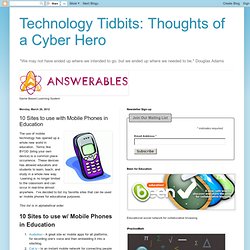

The 60-Second Guide To Texting In The Classroom. Teachers of the 21st century are no longer just intercepting notes as they circulate the classroom. What used to manifest as a simple distraction on a slip of paper has evolved into a tiny symphony of beeps, ring tones and vibrating phones. As technological penetration increases, cell phones are not the only things becoming smaller; cell phone users are younger, and teachers throughout the country are feeling the effects. According to TIME m agazine , “77 percent of teenagers (12-17) have [cell phones], and 75 percent of all teens text.” As cell phone use becomes more common amongst children and teens, the debate as to whether or not mobile phones should be permitted in schools has grown not only amongst teachers, but also amidst parents, administrators, policy-makers and commentators. Although cell phones have the potential to pose a number of problems in the classroom, technologies offered by cell phones can be harnessed to improve student learning.
From Toy to Tool: Cell Phones in Learning. Report: Middle School Students Using Smartphones More Interested in STEM. Mobile Computing | News Report: Middle School Students Using Smartphones More Interested in STEM Middle school students who use mobile devices for school work are more likely to express an interest in STEM subjects, yet there's a large gap in the number of students using the devices at home and those using them in school, according to a new survey from MIT's Center for Mobile Learning at the Media Lab and the Verizon Foundation.

The "Verizon Foundation Survey on Middle School Students' Use of Mobile Technology," comprising online interviews with 1,000 students in grades 6-8 and conducted by TRU, found that 39 percent of respondents reported using smartphones to do homework and 31 percent said they used tablets for the same purpose. Among students who reported using laptops and tablets in class, 67 percent and 55 percent, respectively, told interviewers that the devices helped them learn math and science better. Other findings of the survey include: Four Smart Ways to Use Cell Phones in Class. Digital Tools Teaching Strategies.

10 Sites to use with Mobile Phones in Education. The use of mobile technology has opened up a whole new world in education.

Terms like BYOD (bring your own device) is a common place occurrence. These devices has allowed educators and students to learn, teach, and study in a whole new way. Learning is no longer limited to the classroom and can occur in real-time almost anywhere. I've decided to list my favorite sites that can be used w/ mobile phones for educational purposes. Using Texting to Improve Teen Health. By Rick Nauert PhD Senior News Editor Reviewed by John M.

Grohol, Psy.D. on January 10, 2013 A new study leverages teens’ relationships with cell phones and text messages as a method to enhance health literacy and improve health behaviors. According to the Nielsen consumer research group, U.S. teens receive an average of 3,417 text messages per month or a whopping 114 texts per day. Teens also have notoriously have poor diets, with the U.S. Centers for Disease Control and Prevention reporting that high school students’ consumption of fruit and vegetables is, on average, 1.2 times per day (much lower than the recommended 5 a day).
Given these factors, researchers studied the use of text messages to inform teens about health behaviors. Investigators studied 177 teens for a one-year period. Investigators explored teens’ preferences for message content, format, style (or message ”voice”), origin, and frequency and mode of message delivery. Source: Elsevier. Get Organized With the Latest Smartphone Apps. Who says organization has to be boring? With the latest smartphone applications, your child can keep track of school assignments and have fun along the way.
With stunning graphics and state of the art design, the newest apps will keep even the most reluctant students on track. The truth is that the more organized a student is, the better grades they tend to receive. Check out my top picks for apps that can be quickly downloaded to any iPhone or iPad. For Younger Kids EpicWin — EpicWin is a fun digital organizer your kids will love. One-Third of U.S. High School Students Now Own an iPhone. Piper Jaffray analyst Gene Munster today issued a report on his firm's latest semi-annual survey of U.S. teenagers, the 23rd such survey in the firm's history.

The results of the extensive survey of 5,600 U.S. high school students show that 34% of surveyed students now own an iPhone, an all-time high in the survey and double the percentage seen just a year ago. Furthermore, 40% of surveyed students indicated that they intend to purchase an iPhone within the next six months. Piper Jaffray ascribes the boom in iPhone use among students to new low-cost options from Apple. Apple and AT&T lowered the price of the iPhone 3GS to $49 back in January 2011, dropping it to free on-contract with the introduction of the iPhone 4S late last year.
Smartphone Use: Texting Trumps News & Social Media Nearly 2:1.